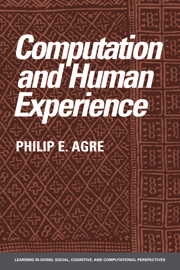Book contents
- Frontmatter
- Contents
- Preface
- 1 Introduction
- 2 Metaphor in practice
- 3 Machinery and dynamics
- 4 Abstraction and implementation
- 5 The digital abstraction
- 6 Dependency maintenance
- 7 Rule system
- 8 Planning and improvisation
- 9 Running arguments
- 10 Experiments with running arguments
- 11 Representation and indexicality
- 12 Deictic representation
- 13 Pengi
- 14 Conclusion
- Notes
- References
- Author index
- Subject index
13 - Pengi
Published online by Cambridge University Press: 07 December 2009
- Frontmatter
- Contents
- Preface
- 1 Introduction
- 2 Metaphor in practice
- 3 Machinery and dynamics
- 4 Abstraction and implementation
- 5 The digital abstraction
- 6 Dependency maintenance
- 7 Rule system
- 8 Planning and improvisation
- 9 Running arguments
- 10 Experiments with running arguments
- 11 Representation and indexicality
- 12 Deictic representation
- 13 Pengi
- 14 Conclusion
- Notes
- References
- Author index
- Subject index
Summary
Argument
This chapter describes a computer program that illustrates some of the themes I have been developing. Before I discuss this program in detail, let me summarize the argument so far. Recalling the scheme laid out in Chapter 2, this argument has three levels: reflexive, substantive, and technical.
The reflexive argument has prescribed an awareness of the role of metaphor in technical work. As long as an underlying metaphor system goes unrecognized, all manifestations of trouble in technical work will be interpreted as technical difficulties and not as symptoms of a deeper, substantive problem. Critical technical work continually reflects on its substantive commitments, choosing research problems that might help bring unarticulated assumptions into the open. The technical exercises in this book are intended as examples of this process, and Chapter 14 will attempt to draw some lessons from them.
The substantive argument has four steps:
Chapter 2 described two contrasting metaphor systems for AI. Mentalist metaphors divide individual human beings into an inside and outside, with the attendant imagery of contents, boundaries, and movement into and out of the internal mental space. Interactionist metaphors, by contrast, focus on an individual's involvement in a world of familiar activities.
As Chapters 1 and 4 explained, mentalist metaphors have organized the vocabularies of both philosophical and computational theories of human nature for a long time, particularly under the influence of Descartes. This bias is only natural. Our daily activities have a vast background of unproblematic routine, but this background does its job precisely by not drawing attention to itself.
Information
- Type
- Chapter
- Information
- Computation and Human Experience , pp. 260 - 301Publisher: Cambridge University PressPrint publication year: 1997
Accessibility standard: Unknown
Why this information is here
This section outlines the accessibility features of this content - including support for screen readers, full keyboard navigation and high-contrast display options. This may not be relevant for you.Accessibility Information
- 5
- Cited by
